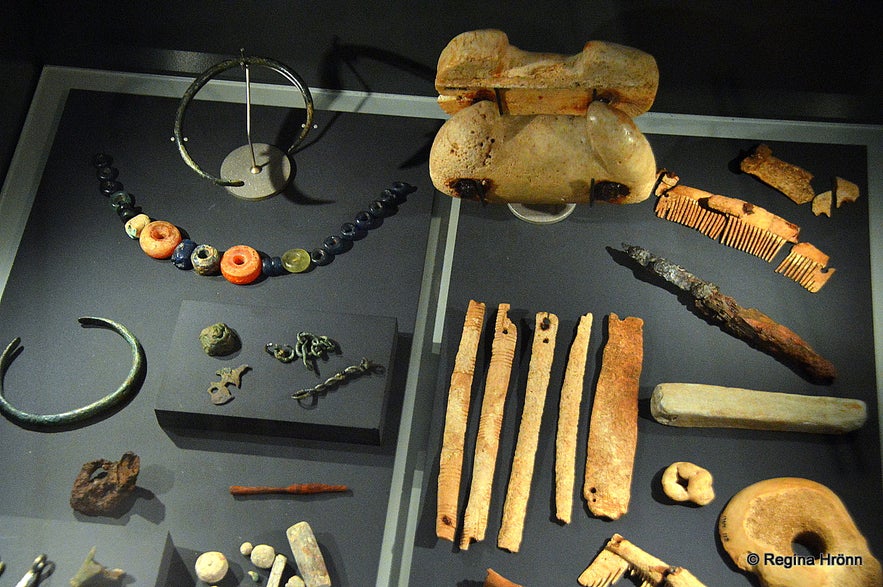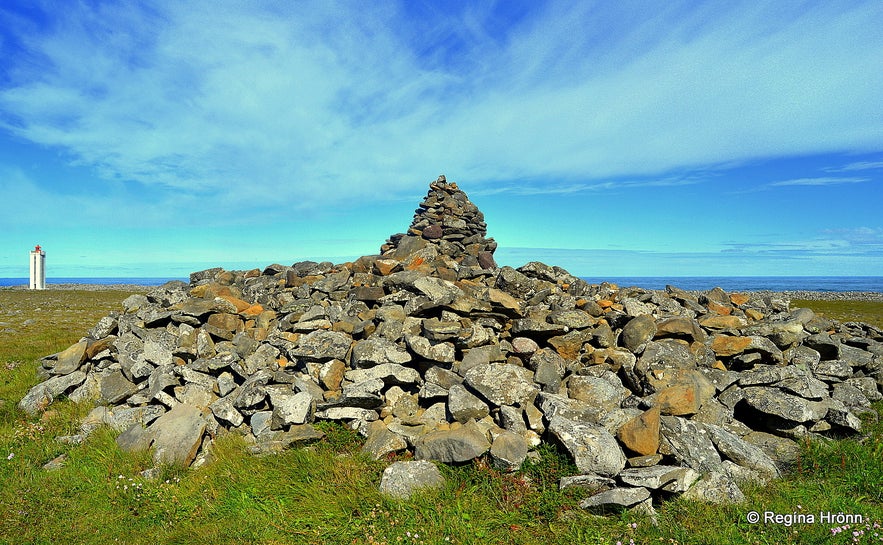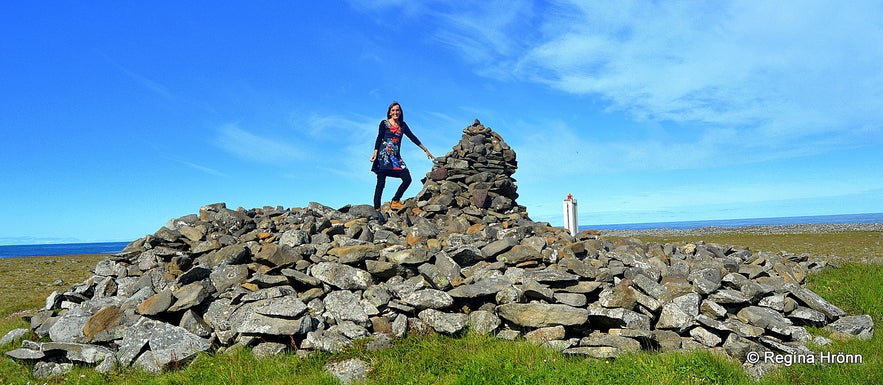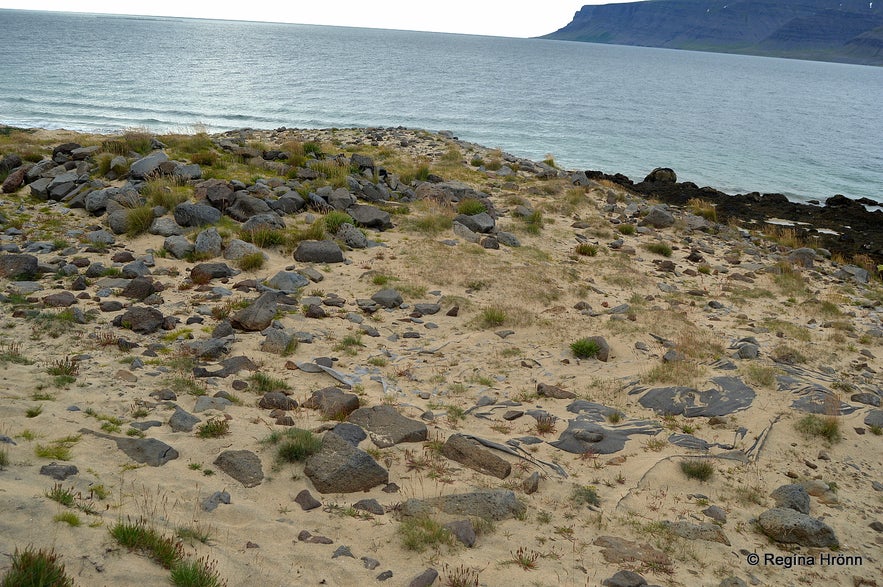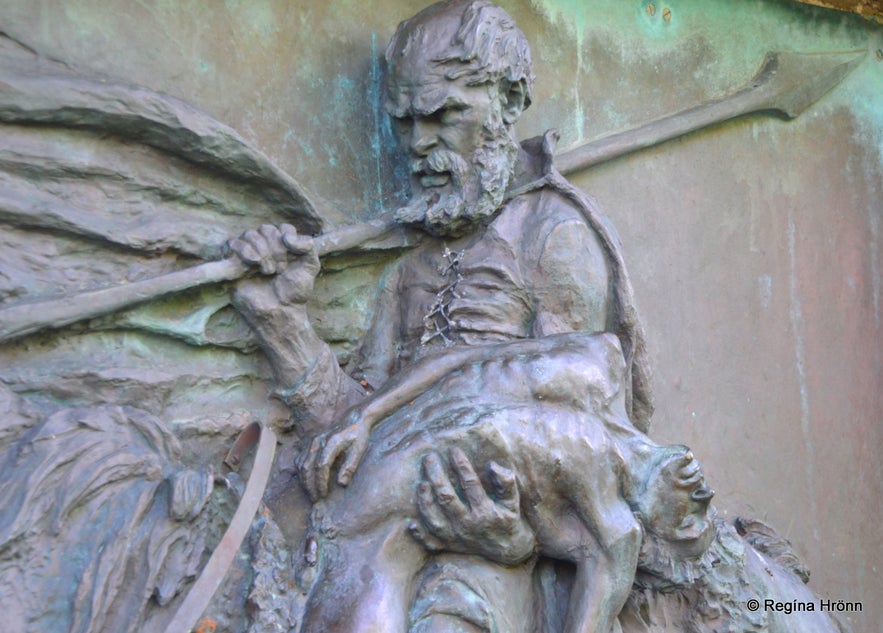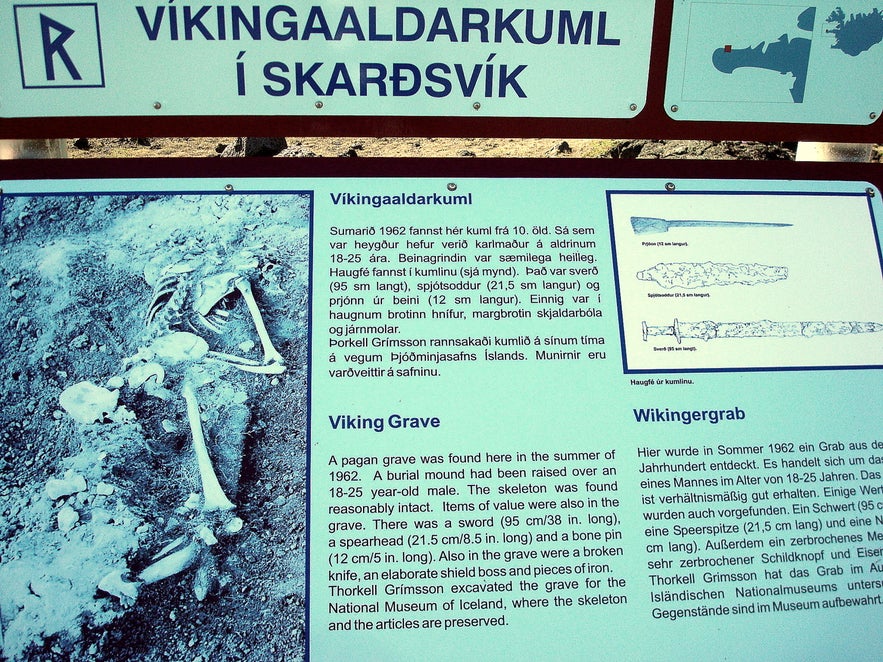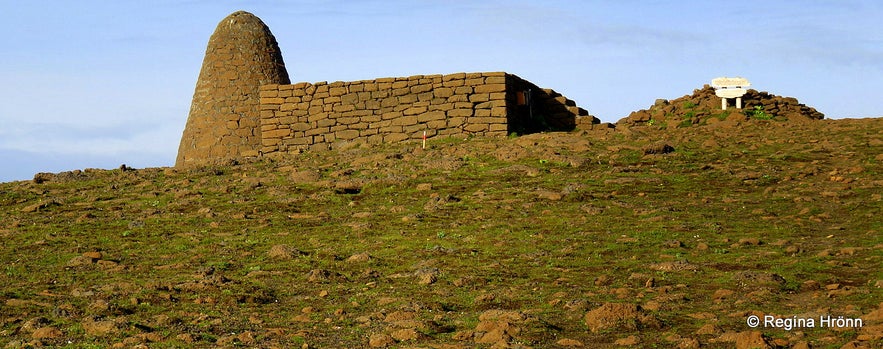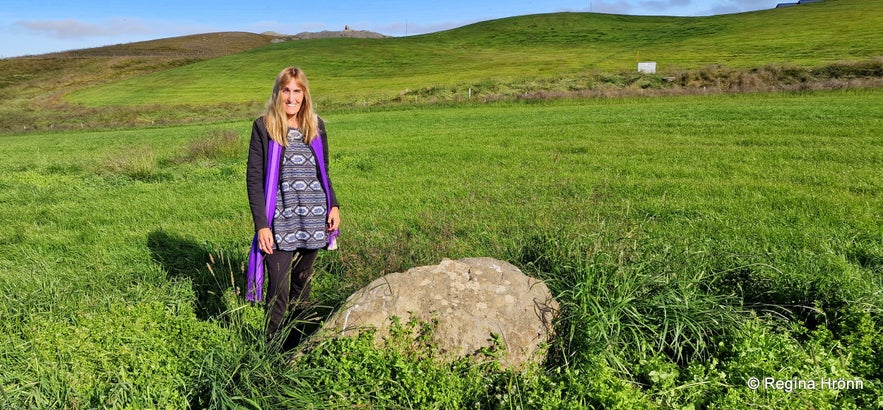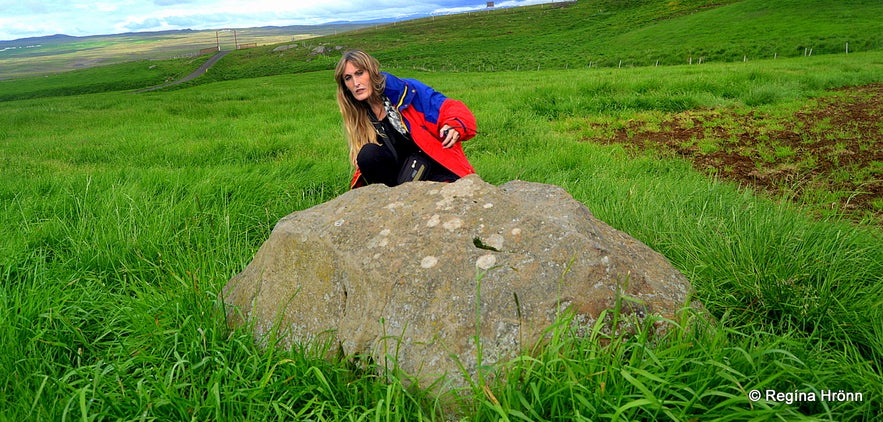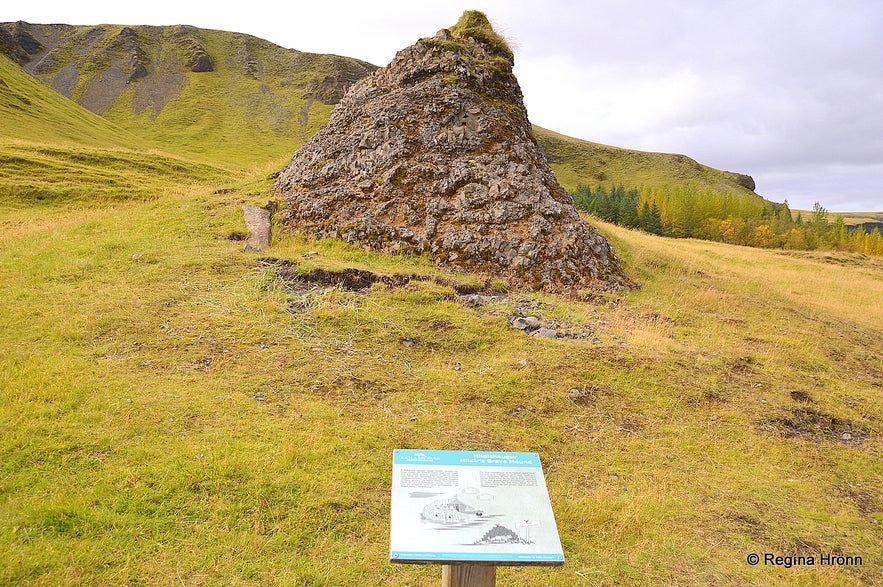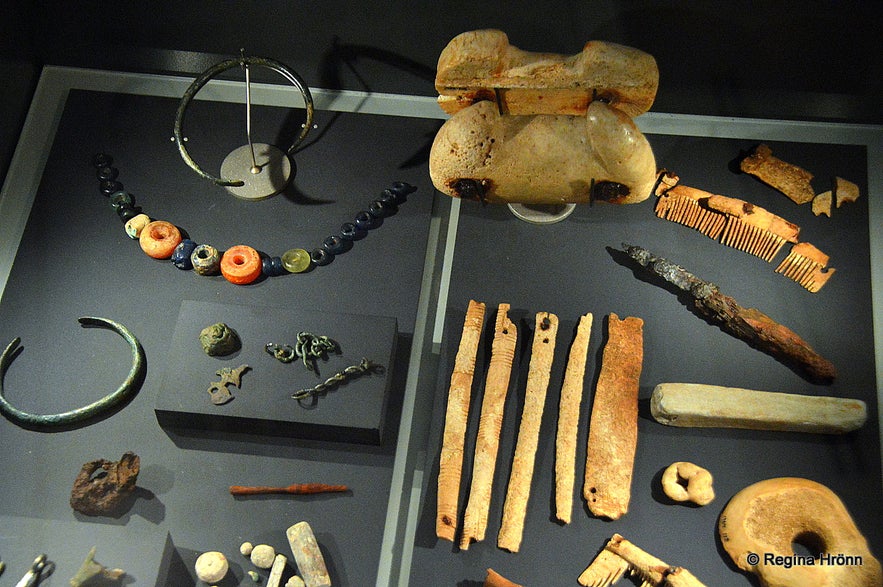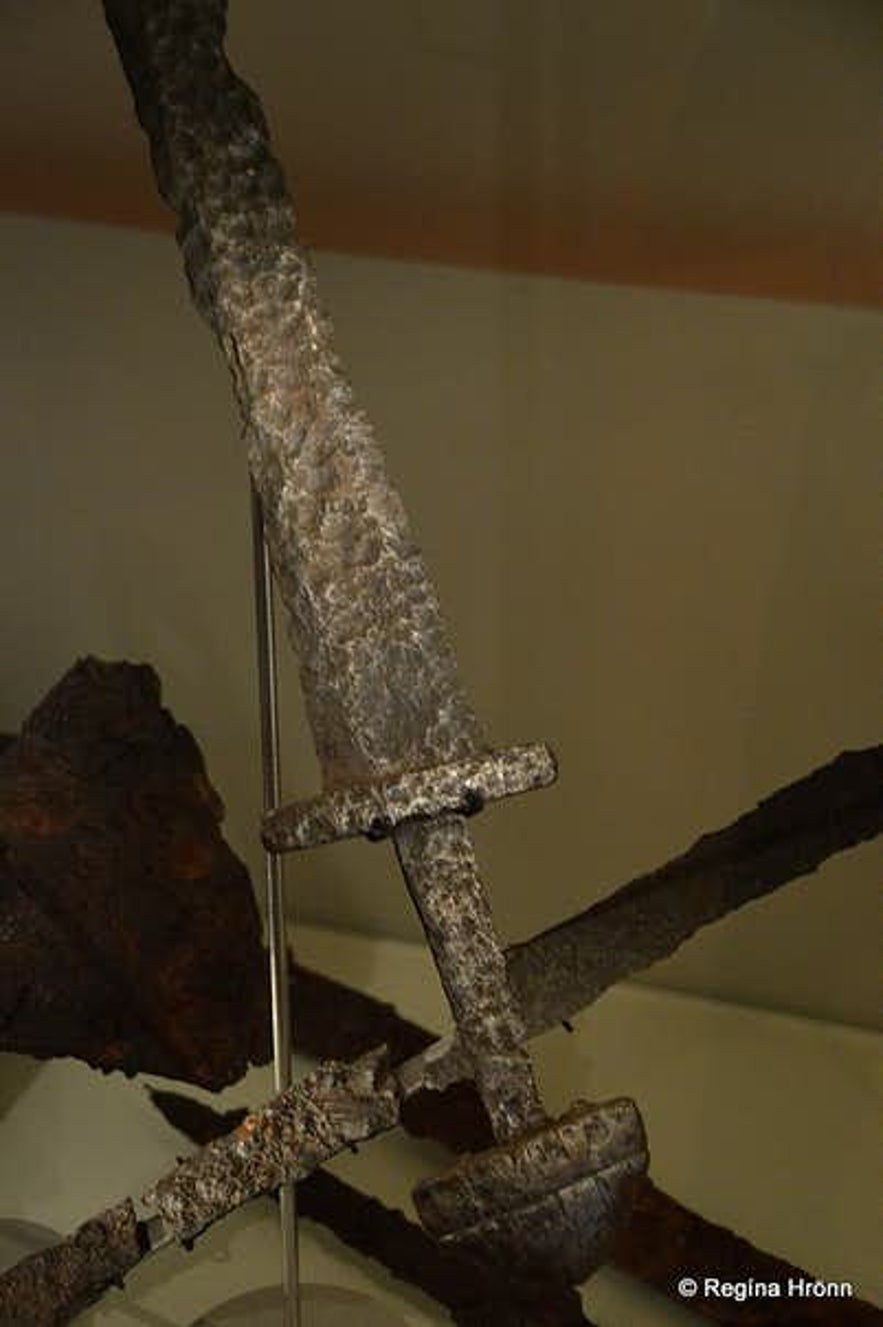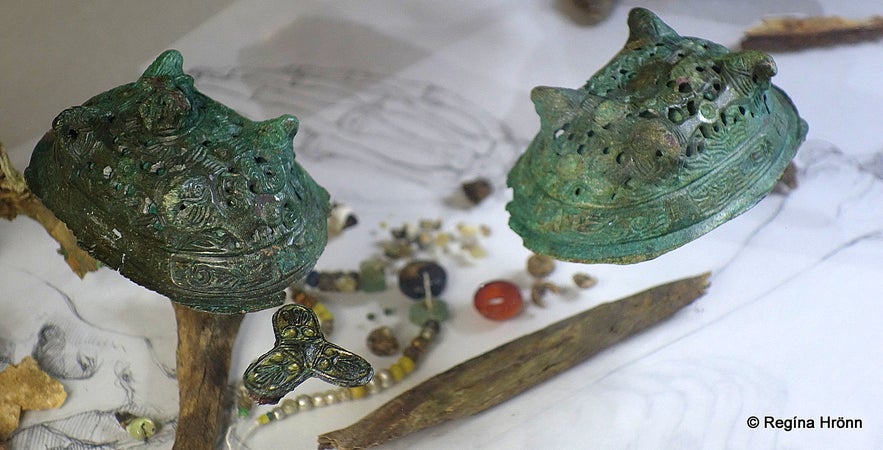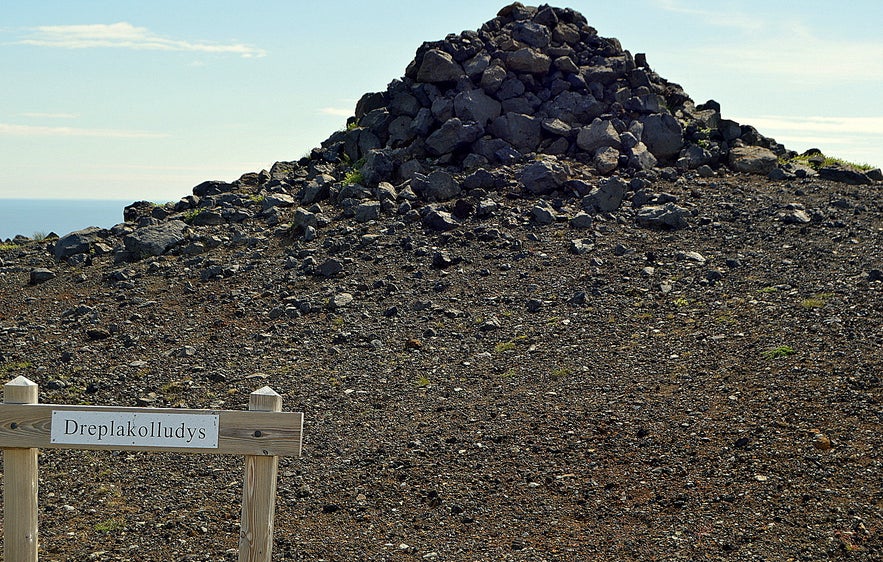
Ancient Viking Burial Mounds and Pagan Graves that I have visited on my Travels in Iceland
- Þorgeirsdys Burial Mound at Hraunhafnartangi
- Hringsdalur in the Westfjords - a Pagan Burial Ground
- Skallagrímshaugur - Skalla-Grímur's Burial Mound
- A Viking pagan grave on Snæfellsnes peninsula
- The Viking Burial Mound of Hjörleifur in Hjörleifshöfði
- The grave of the head of Grettir the Strong at Bjarg
- Hildishaugur Burial Mound
- Hafurbjarnarstaðarkuml pagan graves in SW- Iceland
- Grave goods on display at Þjóðminjasafnið - the National Museum of Iceland
- The Burial mound of Bláklædda konan - the Woman in blue
- Berserkjagata trail and the burial mound of the two Berserks
- Krýsudys and Dísudys on the Reykjanesskagi peninsula
- Rauðs dys - Ruddys - the Burial Mound of Rauður on Barðaströnd
- Djáknadys - Deacon's burial mound in East Iceland
- Völvuleiðið á Hólmahálsi - the Grave of the Prophetess at Hólmaháls in East-Iceland
- The burial mound of Iceland's only serial killer
Archaeologists have discovered several ancient Viking burial mounds and pagan graves in my country, Iceland, some by chance when roads have been built.
In this travel-blog I want to show you the burial mounds and pagan graves that I have visited on my travels in my country.
How we distinguish between pagan graves and Christian graves is that grave goods (haugfé), animals (a horse or a dog), and sometimes boats can be found in pagan graves. This changed with the conversion to Christianity.
Top photo: Grave goods from a pagan grave in Vatnsdalur on display at our National Museum
Þorgeirsdys Burial Mound at Hraunhafnartangi
Þorgeirsdys burial mound at Hraunhafnartangi
In Melrakkaslétta plains at 66 degrees North, you will find a huge heap of stones - which represents the northernmost protected relics in Iceland, declared as protected back in 1931.
This is the burial mound of the Viking Þorgeir Hávarsson - called Þorgeirsdys burial mound. Another burial mound close by is Gautsdys - of Gautur Sleituson.
You can read about Þorgeir (975-1024) in the Saga of Sworn-Brothers (Fóstbræðrasaga), but this old Saga tells us about his life - and his death. I will only tell you about his death in this travel-blog.
Þorgeirsdys burial mound at Hraunhafnartangi
Þorgeir who is described in the Saga as being of such nature that he feared nothing, defended himself Viking style and killed 14 of his attackers.
Þorgeir's torso is buried in the burial mound, but his enemies beheaded him and carried his head with them to Eyjafjörður as proof of their victory.
There were no cameras back then so tangible proof was needed. The same happened to Grettir the Strong, he was beheaded, and his head was presented to his mother, who might have buried the head of her son in her backyard - as you will read a little bit further in this travel-blog.
 Þorgeirsdys and Hraunhafnartangi
Þorgeirsdys and Hraunhafnartangi
Þorgeir's torso is not the only dead body in the burial mound as the other victims of this battle are believed to be buried there also!
I have written another travel-blog on Hraunhafnartangi in North Iceland - one of the Northernmost Spots on the Mainland of Iceland with more photos and information on the burial mound and directions to this remote place in NE-Iceland.
Hringsdalur in the Westfjords - a Pagan Burial Ground
The information sign by Hringsdalskumlið pagan grave
In Arnarfjörður, the second-longest fjords in the Westfjords, you will find Hringsdalskumlið pagan graves.
It was back in 2006 that a thigh bone of a man was found here and archaeological excavations began a little later.
Five pagan graves were found here with human bones and grave goods. Amongst them a spearhead, a comb, a boss (skjaldarbóla), an axe, and a sword. Even a boat grave was found.
Hringsdalskumlið pagan grave in gloomy weather
These old pagan graves are believed to date back to the 10th century.
The settler of Hringsdalur is, according to legend, Hringur. He lost his life in a battle at Hringsdalur.
His mound might have been found here at Hreggnasi in Hringsdalur. That would be amazing - to have discovered the mound of the settler of this area!
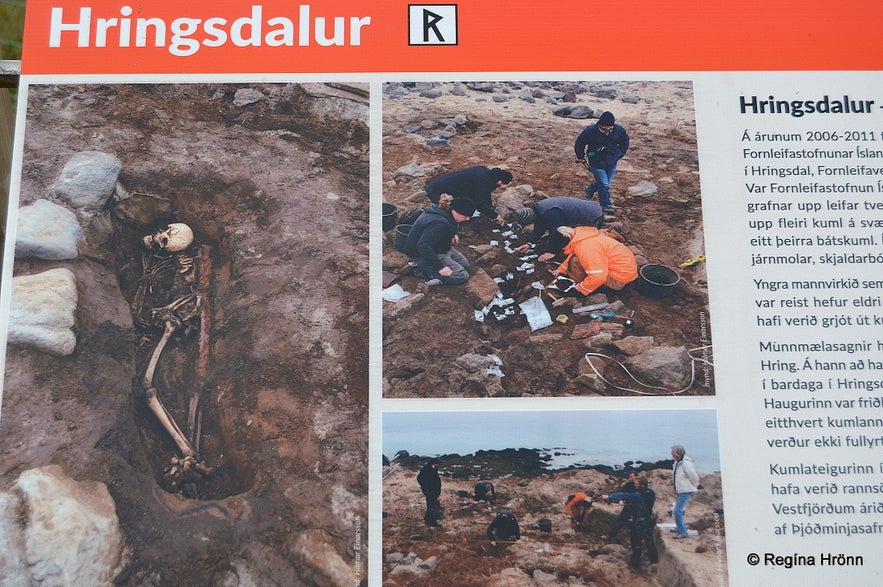 The information sign shows what the pagan graves looked like during the excavation
The information sign shows what the pagan graves looked like during the excavation
His burial mound was declared as protected back in 1930 by the director of the National Museum.
Seeing that the pagan cemetery is so close to the sea, there is a grave danger that the sea will erode these precious Viking remains. And that is, unfortunately, the case with many such sites in Iceland.
Two Viking swords have been found in Hringsdalur valley, one of which is kept at the National Museum of Iceland - you can see a photo of it at Sarpur. The sword was found during road construction.
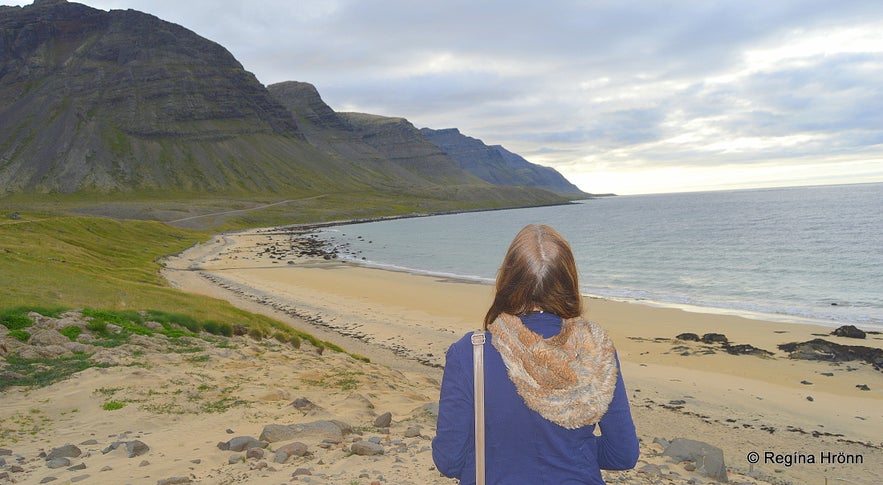 By the pagan graves - there is a lot to see and do in the Westfjords
By the pagan graves - there is a lot to see and do in the Westfjords
Here you can see the location on the map. To reach this area you can drive to the Westfjords from Reykjavík, and explore this less-visited part of Iceland.
Ref.:
Vill fá Hring aftur heim í Hringsdal
Skallagrímshaugur - Skalla-Grímur's Burial Mound
Skallagrimshaugur burial mound
In Borgarnes town in West Iceland, you will find what we would like to believe is the burial mound of the Viking settler Skalla-Grímur Kveldúlfsson and his grandson, Böðvar.
Skalla-Grímur was the father of the well-known hero Egill Skallagrímsson of Egilssaga - the Saga of Egill - and Böðvar was the son of Egill.
Skalla-Grímur seems to have died of an unknown disease. He was buried with his weapons and tools and his horse, as shown in drawings by the mound.
The relief depicting Egill carrying his dead son Böðvar on his horse
When the teenage boy Böðvar drowned in the Hvítá river, his father, Egill, had the burial mound of his father, Skalla-Grímur, reopened and buried Böðvar with his grandfather.
By the burial mound, you will notice a beautiful relief of Egill Skallagrímsson carrying his drowned teenage son Böðvar home on a horse, grief-stricken.
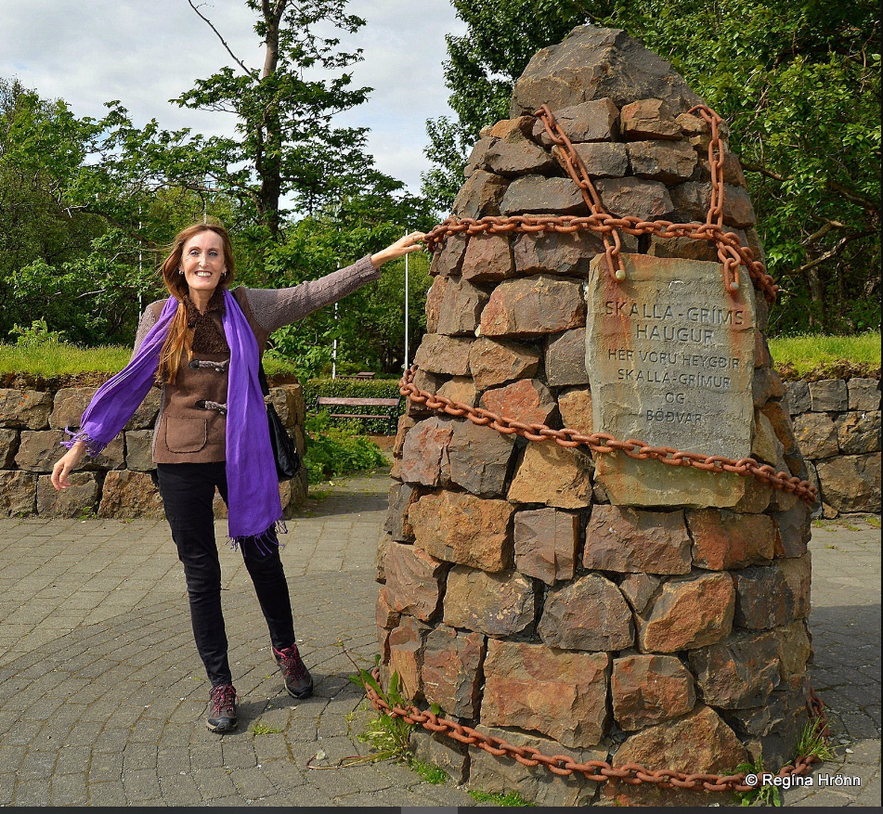
In front of the burial mound, you will see one of the nine cairns that mark interesting locations in the Saga of Egill.
You can read more about these Vikings in my travel-blog the Saga of the Viking Egill Skallagrímsson, the Settlement Centre & the 9 Cairns in West Iceland.
A Viking pagan grave on Snæfellsnes peninsula
The information sign by the pagan grave in Skarðsvík
In 1962, on one of the westernmost points on the Snæfellsnes peninsula in West Iceland, a 10th century, Viking pagan grave was discovered during road construction.
In the grave, a well-preserved skeleton of a young man was found. This young man had been buried with some of his earthly possessions.
This was customary at this time, as I have mentioned earlier, the men were f.ex. buried with their weapons and the women with their jewelry and other things.
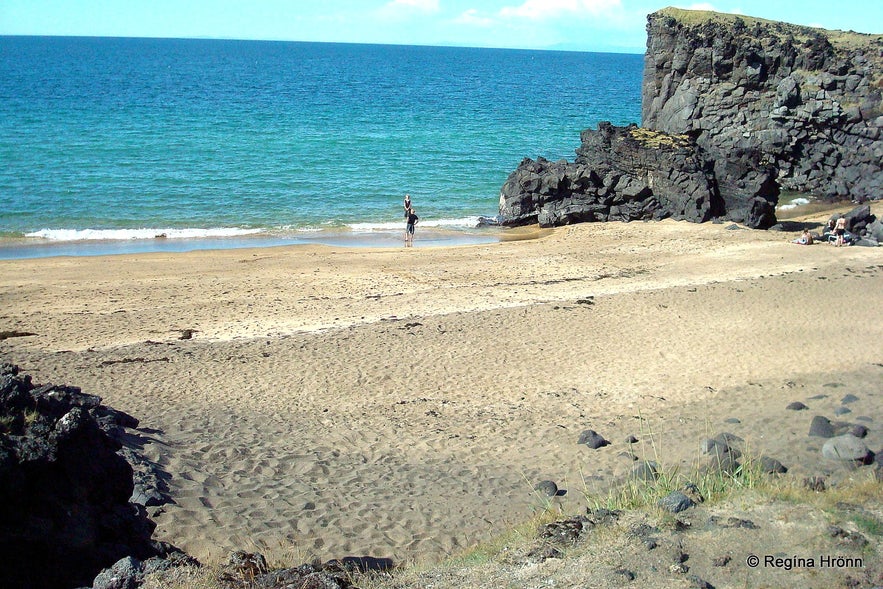
Skarðsvík cove is very popular on a sunny day
Found in the grave of this Viking: a 95 cm long sword ( (see photo in Sarpur), an elaborate boss from his shield, a spearhead, a broken knife, pieces of iron, and a pin made of bone.
The skeleton and the "haugfé" are now preserved at the National Museum of Iceland.
I have written another travel-blog on the Majestic Skarðsvík, Saxhólsbjarg & Svörtuloft on the Snæfellsnes Peninsula in Iceland, where you can see the location and how to get there.
The Viking Burial Mound of Hjörleifur in Hjörleifshöfði 
Hjörleifshaugur burial mound
On the highest point of Hjörleifshöfði promontory in South Iceland, you will find a Viking burial mound, Hjörleifshaugur, where the remains of Iceland's second settler, are believed to be buried.
This Viking settler was Hjörleifur Hróðmarsson, the blood-brother of our first Viking settler Ingólfur Arnarson.
The blood-brothers arrived in Iceland around the year 874 AD, and Hjörleifur was killed by his Irish slaves the year after in 875 AD.
Hjörleifshöfði and Hjörleifshaugur burial mound to the right in this photo
An hour's relatively easy hike will take you up to the top of Hjörleifshöfði.
You can read the story of the blood-brothers in my travel-blog the Historic Hjörleifshöfði Promontory in South-Iceland - Part I - the Blood Brothers Ingólfur and Hjörleifur, where I have added a lot more information and photos plus directions to this historic place.
The grave of the head of Grettir the Strong at Bjarg
The rock where Grettir's head is believed to have been buried, photo taken in 2023
At Bjarg in North Iceland, you will find the birthplace of the Viking outlaw Grettir the Strong (approx. 996 -1040) - and what we would like to believe is a grave with his head.
Grettir was an outlaw for almost 20 years and during the last three years of his life he lived on Drangey island - and there he was slain in around 1040.
Some remains from his time on the island can be seen there.
The rock, Grettisþúfa, where Grettir's head is believed to be buried - photo from 2014
The way Grettir was killed after so many years of being hunted as an outlaw, was that a witch cast a spell on a log - which then landed on Drangey cliff.
Grettir needed firewood, and as he was about to chop up the log, the spell caused his axe to land on his food and cut it badly - causing it to swell up and turn black.
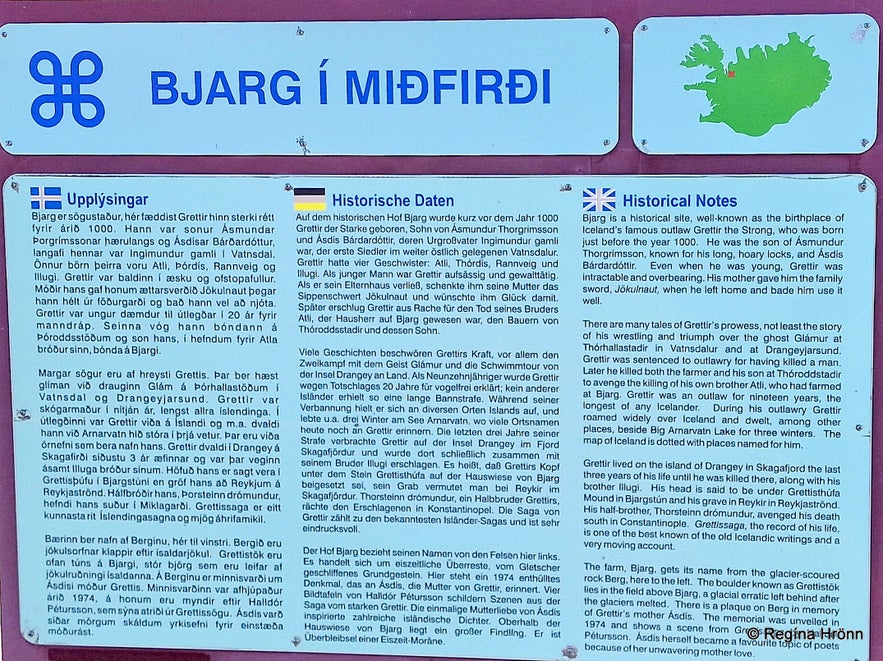 Visiting Bjarg - leave your car by the information sign
Visiting Bjarg - leave your car by the information sign
The enemies of Grettir - the Viking Þorbjörn öngull and his men - climbed up the very steep cliff of Drangey and meant to kill the wounded Grettir.
Þorbjörn Öngull took Grettir's sword and cut off Grettir's head with his sword :(
We, Icelanders, have a hard time reading this chapter in the Saga of Grettir.
Þorbjörn Öngull then presented the head to Grettir's mother, Ásdís at Bjarg.
 The memorial at Bjarg shows the head of Grettir being presented to his mother Ásdís
The memorial at Bjarg shows the head of Grettir being presented to his mother Ásdís
Þorbjörn öngull wanted to bring the head of Grettir to Alþingi at Þingvellir, but the way he killed Grettir when he was ill from the spell, would have been frowned upon.
So on the way to Alþingi, he buried Grettir's head in a sand heap, which was from then on called Grettisþúfa.
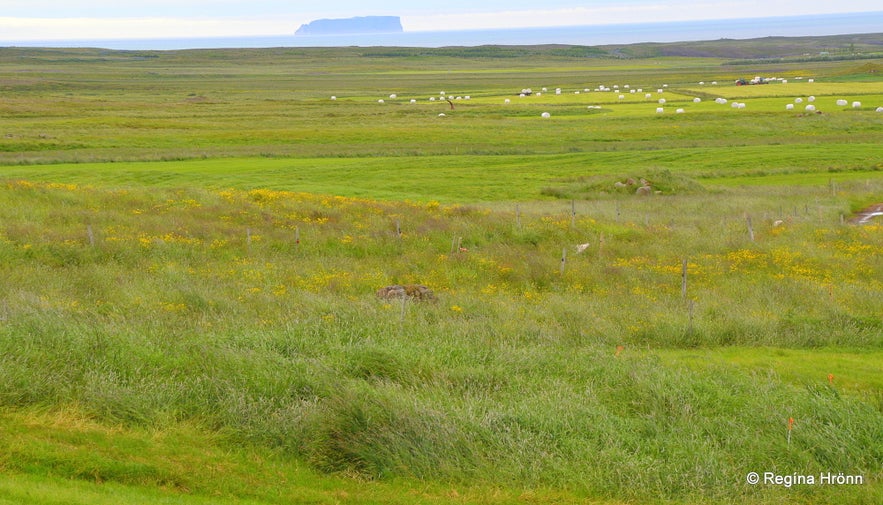 Viðvík farm and Drangey in the distance
Viðvík farm and Drangey in the distance
The Saga of Grettir tells us that Skeggi, the nephew of Grettir, went to Drangey island to fetch the bodies of Grettir and his brother Illugi and buried them by the church at Reykir.
But the head of Grettir was buried at Bjarg.
The farmer of Viðvík in North Iceland, where Þorbjörn öngull lived, told me that the head of Grettir might be buried in this field, but the Saga of Grettir tells us that it is buried at Bjarg.
 Leaving Bjarg farm
Leaving Bjarg farm
You can read more about Grettir's story in my travel-blog on Drangey Bird Cliff in North Iceland and the Viking Grettir the Strong.
To reach this area you can drive to Laugarbakki from Reykjavík in approximately 2.5 hours. Include Borgarvirki and Hvítserkur in your visit.
Hildishaugur Burial Mound
Hildishaugur burial mound
In Kirkjubæjarklaustur in South Iceland, you will find the burial mound of Hildir Eysteinsson. The information sign says:
"The first inhabitants at Kirkjubær were Irish hermits and the story goes that heathens were forbidden to live there.
The Christian Settler Ketill lived all his life at Kirkjubær, but when the pagan Hildir Eysteinsson planned to move there, "he fell dead as soon as he set foot on the estate and he is buried in Hildishaugur".
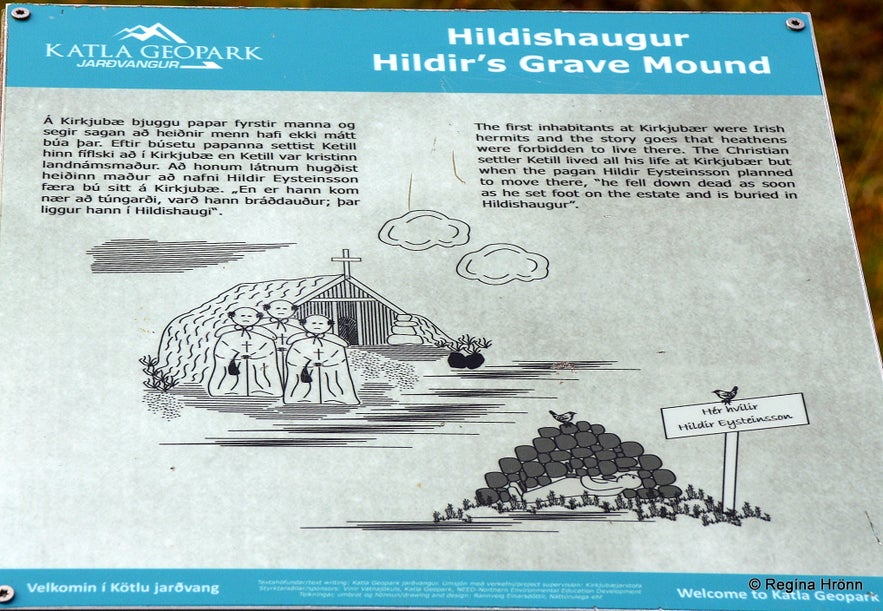 The Katla Geopark information sign by Hildishaugur
The Katla Geopark information sign by Hildishaugur
Chapter 85 of Landnáma - the Book of Settlements tells us that the Christian Ketill sailed to Iceland from the Hebrides (Suðureyjar) and settled at Kirkjubær, where Papar had resided, and that no heathen men were to reside there.
Ketill fíflski was the son of Jórunn mannvitsbrekka, who was the daughter of Ketill flatnefur, but her siblings were amongst the best-known settlers in Iceland, as I have shown you in other travel-blogs.
Hafurbjarnarstaðarkuml pagan graves in SW- Iceland
A pagan grave of Hafurbjarnarstaðir is on display at the National Museum - a woman (a child skeleton is also on display)
At our National Museum, you will see the skeleton and the grave goods of the so-called Hafurbjarnarstaðarkuml - the pagan graves at Hafurbjarnarstaðir between Garður and Sandgerði on the Reykjanes peninsula in SW Iceland.
The woman shown at our National Museum was around 40 when she died and she was unusually tall, as you can see from the length of her legs.
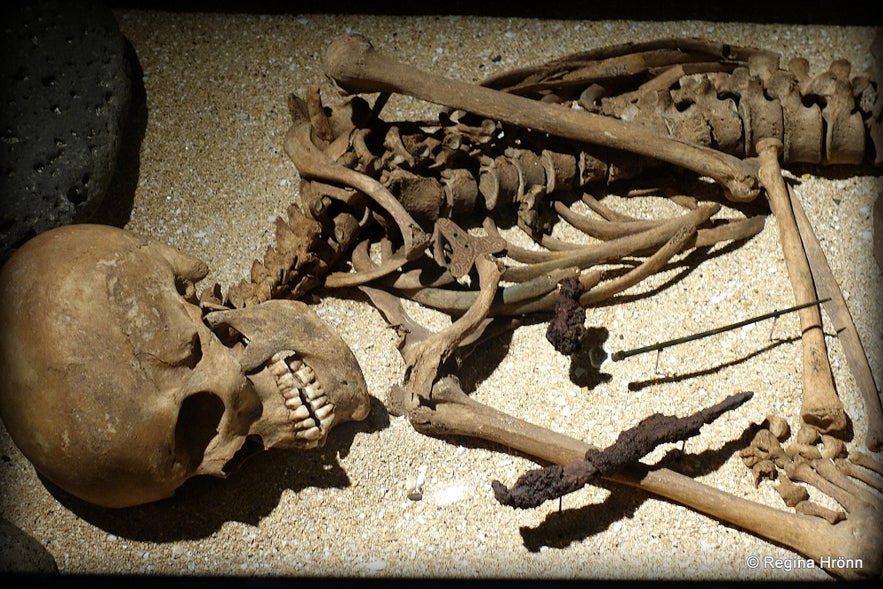
A pagan grave at the National Museum
She has some plain objects with her; a knife, a trefoil broach, a ringed pin, 3 shells, a comb, and a stone called "lausnarsteinn" in Icelandic, which was believed to help women in labour.
Next to her in a separate showcase is the skeleton of an 8-month-old child also found at Hafurbjarnarstaðir.
The bones are well preserved as the sand in this area is shell sand, which has a different acidity from the more normal black sand in Iceland.
Let us always show utter respect when examining these skeletons at the National Museum.

At Hafurbjarnarstaðir - you can see the two lighthouses at Garður in the distance
Here at Hafurbjarnarstaðir, some 9 pagan graves were discovered. A Viking sword, dating back to the 10th century, was found in the pagan graves and you can see a photo of it here at Sarpur.
I visited Hafurbjarnarstaðir for the first time in the summer of 2020. I searched for the yellow "Friðlýstar minjar" - a preserved relics sign for the longest time, which indicates where the site is located.
I almost gave up on finding the site, when I spotted it from afar. There is not much to see there, but I found 2 yellow signs.
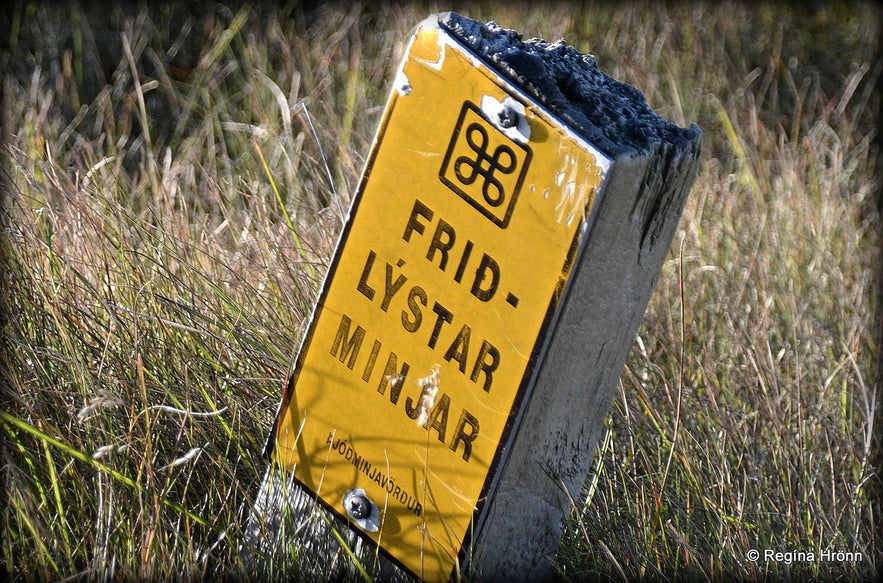 Friðlýstar minjar - preserved relics
Friðlýstar minjar - preserved relics
When I am searching for such spots in Iceland many times I have a hard time finding them and have to do some research and then comb the area when I get there.
Sometimes the yellow sign that was supposed to be there as an indication that this is an archaeological site or a preserved site, has disappeared, either it has blown away it has got damaged, and might be beneath the grass somewhere.
Grave goods on display at Þjóðminjasafnið - the National Museum of Iceland
Grave goods from a pagan grave in Vatnsdalur in the Westfjords of Iceland
Some Viking artifacts have been discovered in pagan graves and by chance during road construction or because of soil erosion.
When you enter the National museum, you will f.ex. see grave goods from a boat grave in Vatnsdalur in Patreksfjörður in the Westfjords of Iceland.
It is believed that a Viking woman was buried with her boat and that six more people were buried with her later on.
Viking swords at the National Museum of Iceland
You can also see several of the Viking swords that have been found, on display at Þjóðminjasafn Íslands - the National Museum of Iceland.
Around 21 Viking swords have been found - 14 of them in pagan graves dating back to the 9th and 10th centuries.
I recently attended a lecture on Viking swords at the National Museum and got these numbers at that lecture.
Stöðutákn og skaðræðistól - Víkingaaldarsverð á Íslandi. Ármann Guðmundsson (in Icelandic)
Viking swords at the National Museum.
The Viking sword to the left in my photo above was found at Skjaldbreiður and dates back to 1250-1300 Sarpur.
The Viking sword to the right was found by the farmer at Skógar in Fnjóskadalur and dates back to 1300-1400 Sarpur.
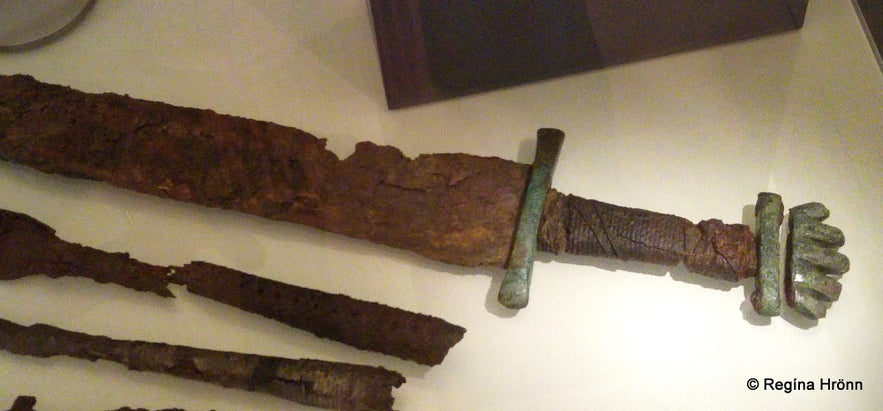 Kaldárhöfðasverðið found in a burial mound near Lake Úlfljótsvatn
Kaldárhöfðasverðið found in a burial mound near Lake Úlfljótsvatn
The Viking sword in my photo above is referred to as the Kaldárhöfðasverðið sword and is 91 cm long. It was found when a burial mound opened up by itself by the lake shore of Lake Úlfljótsvatn and is believed to date back to the first part of the 10th century - Sarpur.
This sometimes happens due to erosion of the shore of lakes and by the sea. Some of the old artifacts might even have been lost due to the erosion of the lake and sea shores.
One of the Viking swords was found by chance by two goose-hunters back in 2016. Another one was found in June 2017 at Dysnes in Eyjafjörður close to Gásir.
The Viking sword from Dysnes - it is longer but difficult to photograph
In May 2018 a temporary exhibition opened at the National Museum on the extraordinary archaeological artifacts discovered at Dysnes in North Iceland, where 2 boat graves were found, a Viking sword and armour, a silver ring, broaches, and a myriad of nails from the boats.
I attended the lecture and the opening of the exhibition at the National Museum as I am very interested in these archaeological finds as you might have guessed ;) Here is a video of when the archaeologists dug out the very fragile Viking sword
The Burial mound of Bláklædda konan - the Woman in blue
From the exhibition Bláklædda konan - the Lady in Blue
Sometimes there are temporary exhibitions at the National Museum of Iceland, f.ex. one that showed us the extraordinary find in 1938 in East Iceland - of the still preserved cheek of a Viking woman - referred to as Bláklædda konan - the Woman in blue.
I attended a lecture at our National Museum and after the lecture, we were guided through the exhibition.: Bláklædda konan. Freyja Hlíðkvist Ómarsdóttir (in Icelandic).
The remains of this Viking woman, who is believed to have died in the 9th century, were found in her pagan grave with some grave goods.
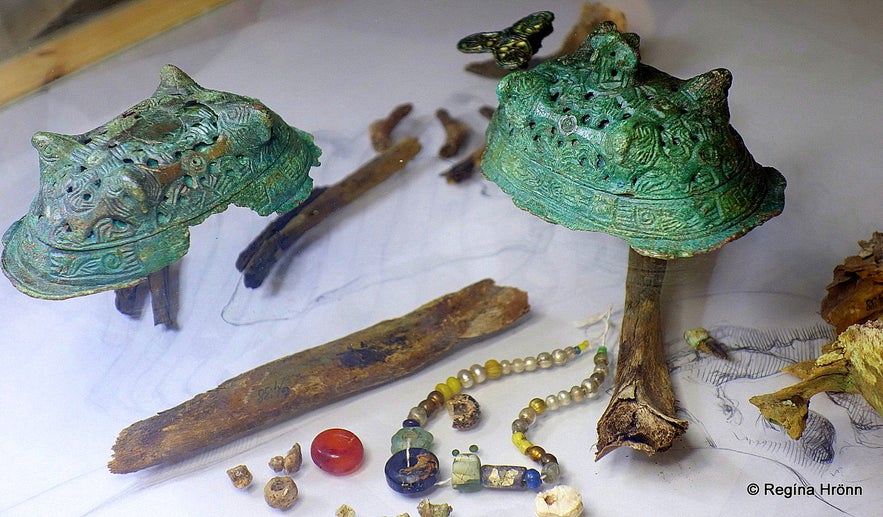
Two convex copper broaches of the Woman in blue
She was laid to rest with her left cheek touching a copper broach, which prevented the flesh from decaying. It is indeed a rare find!
Pieces of cloth, blue in colour, were also preserved due to the poisons in the broach.
Berserkjagata trail and the burial mound of the two Berserks

By the burial mound of the two Berserks
On the Snæfellsnes peninsula, you will find a burial mound of two Berserks, Halli and Leiknir, who according to Eyrbyggja and Heiðarvíga Saga were killed by Víga-Styr the Slayer after having built the old Berserkjagata road for him and stacked Berserkjagarður lava fence.
The road they built through the lava is believed to be the oldest man-made road construction in Iceland of which the builders are known.
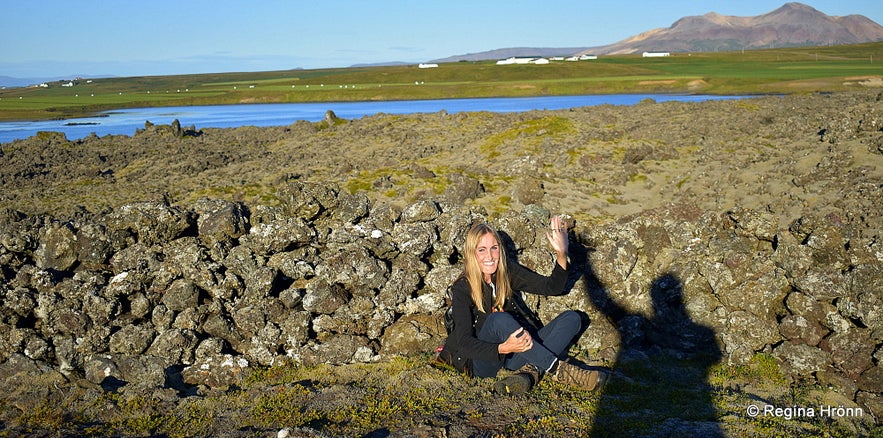
By Berserkjagarður lava fench
I have written another travel-blog where I tell you about Berserkjagata in more detail:
Krýsudys and Dísudys on the Reykjanesskagi peninsula
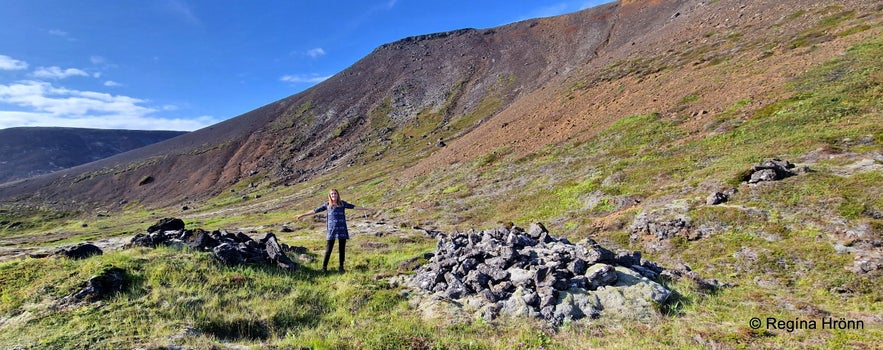 Krýsudys and Dísudys burial mounds - the shepherd's burial mound on the hill
Krýsudys and Dísudys burial mounds - the shepherd's burial mound on the hill
Folklore tells us about Kerlingadysjar burial mounds, the burial mounds of Krýsa and Dísa, and the shepherd on the Reykjanesskagi peninsula.
The preserved burial mound of Krýs is to the left in my photo above and the burial mound of Dís (Herdís) is to the right.
And on the other side of the preserved path is the burial mound of the shepherd of Krýs, Smaladys.
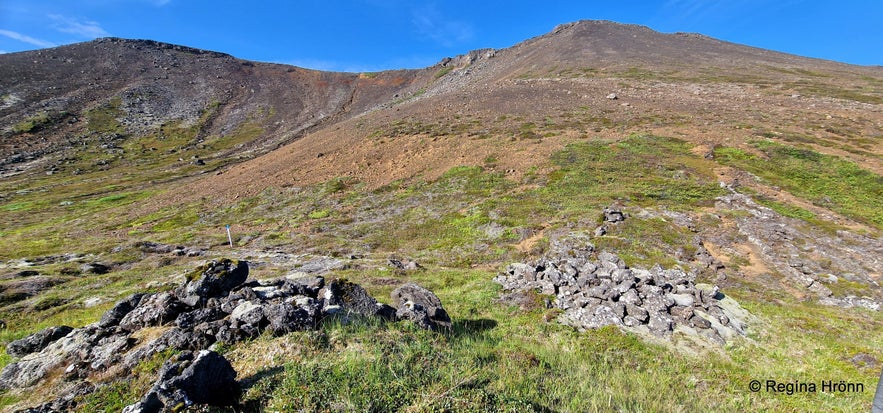 The 3 burial mounds
The 3 burial mounds
Just to tell you a little bit about Krýsa and Herdís, then they are said to have been the daughters of Þórir haustmyrkur the settler of this area, but now we are speculating.
Krýsa lived in Krýsuvík, but Herdís in Herdísarvík. They quarreled over landmarks between their lands. Krýsa wanted to own the whole of Mt. Geitahlíð and wanted the landmark to be by a big rock that stands in the lava by the east side of the mountain.
Herdís wanted to own the land by Deildarháls. It is a little bit west, but beneath the middle of Mt. Geitahlíð and has spewed fire, as there is a large crater. From this crater, the lava called Klofningur or Klofningar ran.
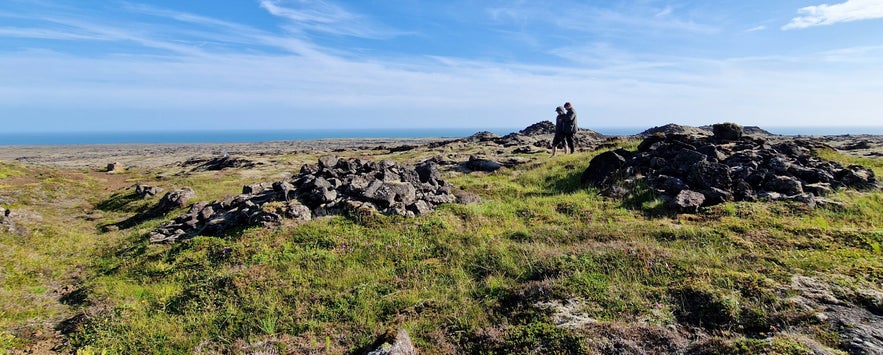 The preserved path between the 3 burial mounds
The preserved path between the 3 burial mounds
There they met and quarreled until they both died and their burial mounds are by a ridge beneath the mountain slope. We can speculate that Herdís was the first to arrive.
Until this time there had been good fishing in Lake Kleifarvatn in the land of Krýsuvík and in the trout pond by Herdísarvík.
Herdís put the curse on Lake Kleifarvatn that all the trout should be inedible fur-bearing trout (poisoned).
And Krýsa put a curse on Herdísarvík that all the trout would turn into stickleback and the farm would be ruined.
(Translated and recapitulated from Krýsa and Herdís in Þjóðsögur Jóns Árnasonar - the Compilation of Folklore by Jón Árnason)
 By Lake Kleifarvatn
By Lake Kleifarvatn
You remember the yellow sign that I have told you about which indicates that you are visiting a preserved site, well, by Kerlingadysjar it seems to have blown away, as there was nothing to indicate that I was here by preserved burial mounds. So it was a little difficult to find the burial mounds.
Rauðs dys - Ruddys - the Burial Mound of Rauður on Barðaströnd

By Ruddys
I recently visited Barðaströnd and stayed at Rauðsdalur as I wanted to see the magnificent Reiðskörð volcanic dykes.
I stayed by the Reiðskörð for a couple of hours as I was waiting for the tide to go out, and then walked for 1.5 km by the sea, as I also wanted to see where the burial mound of Rauður in Rauðsdalur is supposed to have been.
 Reiðskörð volcanic dykes
Reiðskörð volcanic dykes
This was my first visit to Ruddys and I didn't know what it looked like, but after 1.5 km I saw what looked like a wall of basalt columns.
Here by the basalt columns, Rauður was supposedly buried.
According to oral tradition, Rauður was the Settler of Rauðsdalur valley, and this area, but we cannot find a source for it as he is not mentioned in Landnámabók - the Book of Settlements.
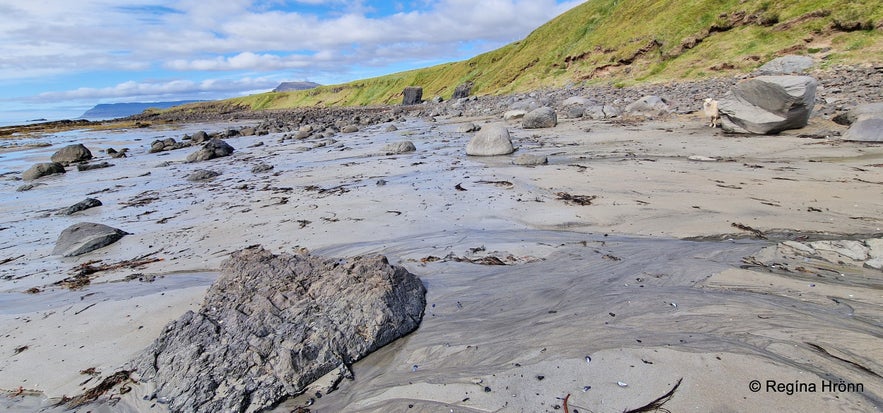 Here you can see the rock from afar. And a sheep looked at me from behind a rock
Here you can see the rock from afar. And a sheep looked at me from behind a rock
My husband went to get the car and didn't come down to the beach, but took photos from above.
I look for burial mounds in Iceland, so I couldn't miss visiting the burial mound of Rauður, but he is less interested in this subject.
 Ruddys as seen from above
Ruddys as seen from above
It is well worth visiting as the basalt columns are magnificent here. The basalt column rock by Ruddys. is one meter thick and 5-6 meters wide.
The basalt columns look like Kirkjugólfið - the Church floor - by Kirkjurbæjarklaustur.
I love basalt column formations and seek them out on my travels around Iceland.
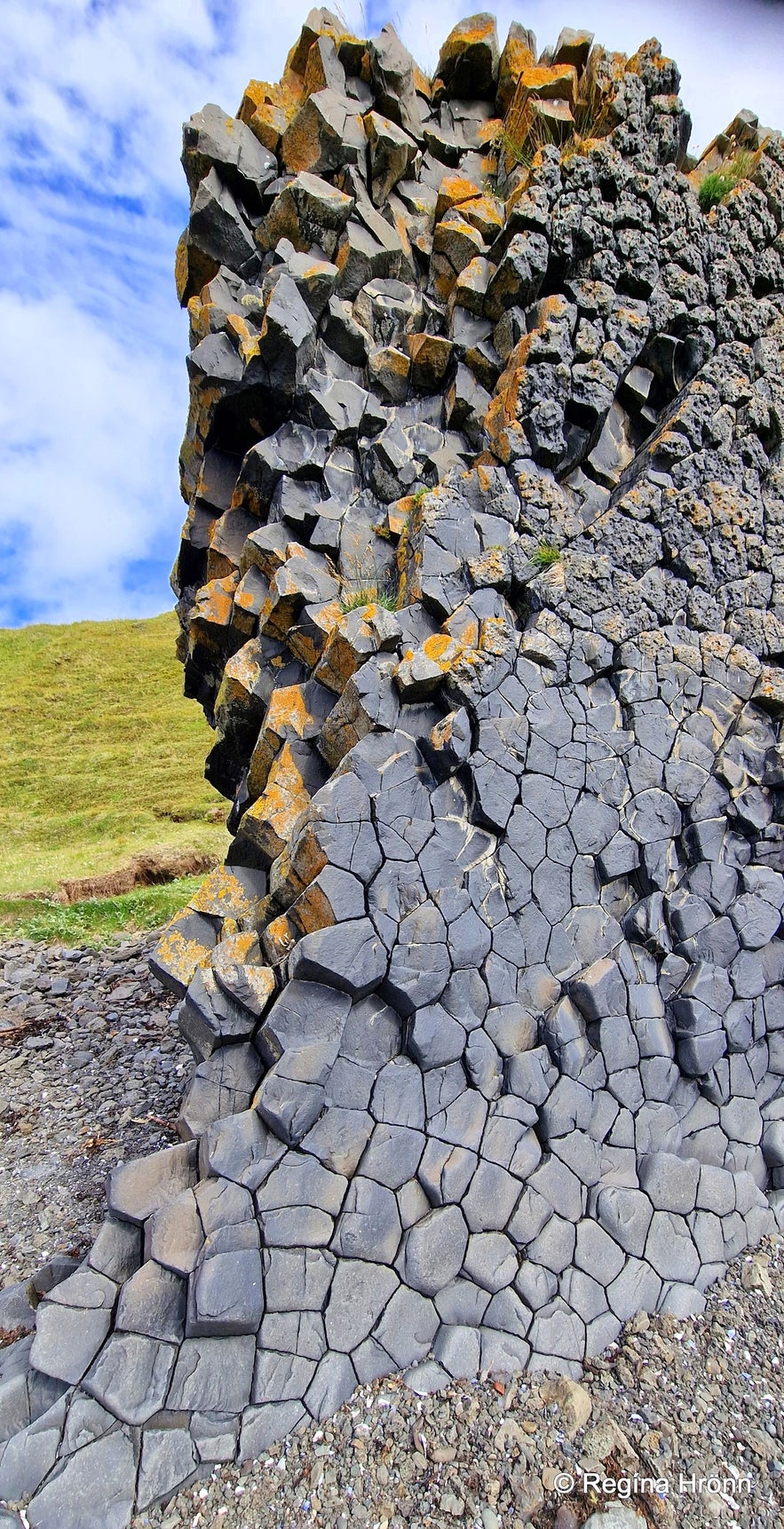 Magnificent basalt columns
Magnificent basalt columns
You cannot see the basalt column rock from the road and it is a bit of a climb down to it, so it is best to reach it by walking on the beach from Reiðskörð.
-------------------------------
There are a couple of other burial mounds that I have visited, which are not from the Viking era.
There is folklore connected to two burial mounds in the Eastfjords, and that is the only thing we know about these preserved burial mounds.
Djáknadys - Deacon's burial mound in East Iceland
Djáknadys burial mound
In Hamarsfjörður in East Iceland, a huge heap of stones can be seen by the road.
Here, according to legend, the deacon of Hamar and the pastor of Háls fought to their death - we have no idea why they were fighting.
They were both buried here and the burial mound is called Djáknadys or Deacon's burial mound.
It is well marked with 2 signs showing that this site is preserved plus an information sign and parking.
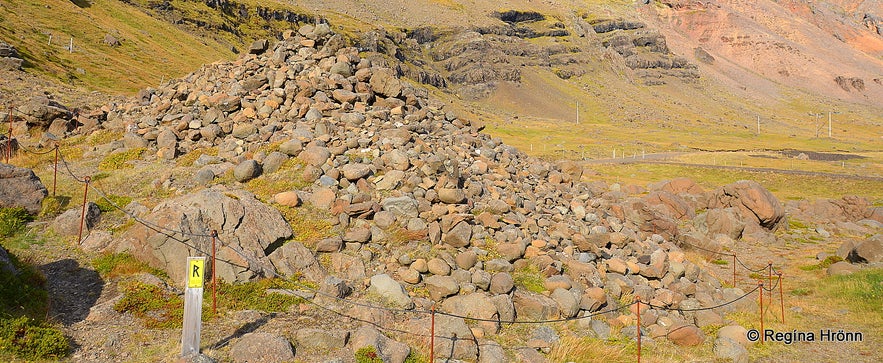
When you first pass by Djáknadys, it is traditionary to throw a stone onto the mound, so you won't lose your way. I did so when I first stopped by Djáknadys.
I have noticed this tradition of throwing a stone or two on the burial mound in folklore. And even in Reykjavík it was customary to throw a rock on Steinkudys who was buried at Skólavörðuholt behind Hallgrímskirkja church, one of the landmarks of Reykjavík.
Steinunn and Bjarni from Sjöundá by Rauðasandur in the Westfjords of Iceland had murdered their spouses and had been sentenced to death.
Völvuleiðið á Hólmahálsi - the Grave of the Prophetess at Hólmaháls in East-Iceland

Völvuleiðið á Hólmahálsi - the Burial mound of the Prophetess at Hólmaháls East-Iceland
On Hólmaháls between Reyðarfjörður and Eskifjörður in East Iceland, you will find a burial mound of a Prophetess, who is now the protector of this area.
I don't know how old this burial mound is, but I found her story in Þjóðsögur Jóns Árnasonar - the Compilation of Folklore by Jón Árnason volume IV - page 124:
"Once upon a time there was a prophetess; she was very wise. It is not mentioned where she lived, but before she died, she asked to be buried in Reyðarfjörður, from where there was the best view of the sea - she said that pirates would not be able to conquer Reyðarfjörður while her grave was visible.
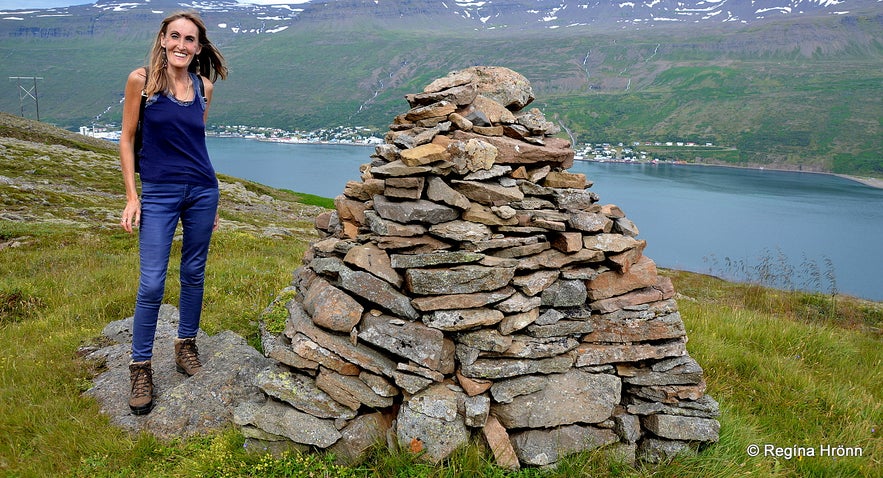
Völvuleiðið á Hólmahálsi - the Burial mound of the Prophetess at Hólmaháls East-Iceland
She was buried on the spit leading from Hólmatindur which is called Hólmanes. It splits the main fjord into Reyðarfjörður and Eskjufjörður; it is high up and the view from there toward the sea is ideal. The thoroughfare leads through here and the grave is right by it; it looks like a green tussock.
Pirates sailed their ships here and meant to reach Reyðarfjörður, but as they arrived at the mouth of the fjord it appeared to them as the whole fjord and land were on fire and they were forced to leave (this was maybe in 1627 when pirates came ashore in Djúpavogur and the Westman islands); the prophetess was thanked for this."
(Þjóðsögur Jóns Árnasonar - the Compilation of Folklore by Jón Árnason volume IV - page 124).
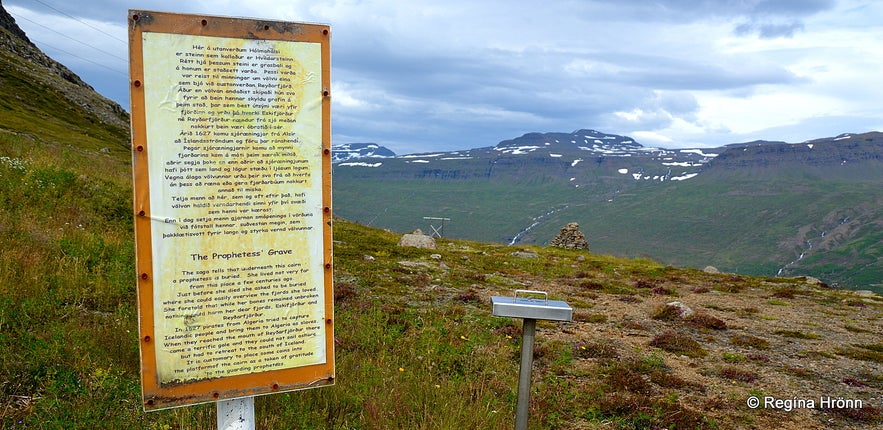
The information sign by the burial mound at Hólmaheiði
The burial mound is well-marked with the yellow sign and an information sign. From here is a beautiful view of Eskifjörður and the surrounding area.
The burial mound of Iceland's only serial killer
The Axlar-Bjarnardys burial mound sign
By Hellnavegur road on the Snæfellsnes peninsula, you will find a burial mound, one of 3 that is still standing.
Customary cairns were stacked here in Iceland to show the way, and then you will see them in a row, but this lone cairn is one of the burial spots of the most notorious serial killer in the history of Iceland.
Axlar-Björn was his name and he murdered around 9-18 people, that we know of, many of them were wanderers and people passing by his farm, Öxl on the south side of the Snæfellsnes peninsula in West Iceland. He robbed them of their possessions and threw the bodies into a pond, Íglutjörn.
Drepakolludys burial mound
According to Þjóðsögur Jóns Árnasonar - the Collection of Folklore of Jón Árnason Axlar-Björn killed his victims with an axe which he had found under a rock on Mt. Axlarhyrna above his farm. This axe made Axlar-Björn go on a killer spree.
Axlar-Björn was executed in 1596 at Laugarbrekka. All of his limbs were broken with a sledgehammer before he was beheaded. He was such a dangerous person that people feared that he would return and hunt them so his body was cut into pieces and put in 3 cairns.
The remaining cairn on Laugarholt by the road is called Dreplakolludys and is now protected. The other 2 cairns were destroyed during the construction of the Hellnavegur road.
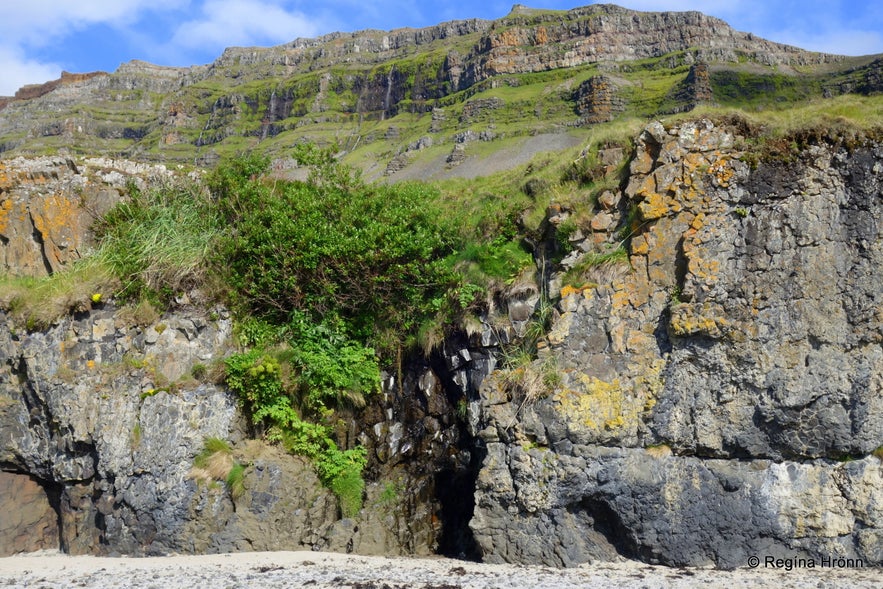 Skottagjá on Barðaströnd where Sveinn skotti was hanged
Skottagjá on Barðaströnd where Sveinn skotti was hanged
The son of Axlar-Björn, Sveinn skotti, was born after the execution of Axlar-Björn.
He seemed to have inherited the same evil blood as his father and was hanged in 1648 on Barðaströnd after attempting to rape the farmer's wife at Rauðsdalur. -
And his son, Gísli hrókur, was hanged as well at Dyrhólaþing in South Iceland.
You will find this cairn on the south side of the Snæfellsnes peninsula. Here is the exact location on the map.
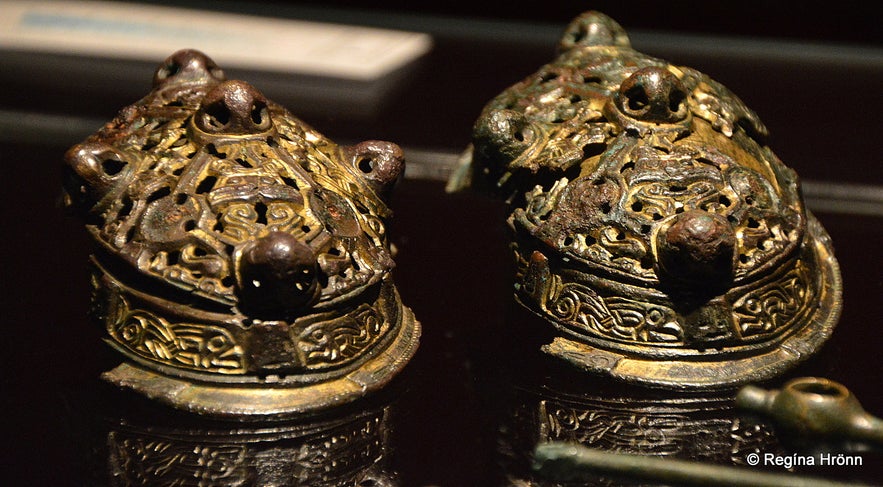
Beautiful broaches have been found in burial mounds
These are the burial mounds and pagan graves that I have visited on my travels around my country. This is a work in progress, and I will be adding to it if I stumble upon more burial mounds in Iceland.
There is f.ex. a very interesting archaeological dig in Fjörður in East Iceland where many pagan graves and longhouses have been discovered. In the pagan graves, 150 pearls have been found, scissors, gold (which is a rare find indeed), parts of the clothes the woman was wearing, and a piece of glass from a mirror, which is also rare to find.
I hope that this list enriches your Iceland visit. As often people drive by interesting places without knowing that they exist.
I have written another travel-blog listing the Ancient Archaeological Viking Ruins I have visited on my Travels in Iceland.
Have a lovely time in Iceland :)
Читать другие блоги
Загадка отеля Radisson 1919
Из истории славного города Рейкьявика Каждый умный человек знает, что свастика, как древний положительный символ движения, благоденствия, солнцеворота, не имеет ничего общего с преступным нацистскимЧитать далееАвтобусы в Рейкьявике и Исландии
Привет, ребята Сейчас очень быстро, без лирических отступлений, расскажу вам об общественном транспорте Рейкьявика - автобусах Stræto. Эти знания вам очень пригодятся, если, приехав в Рейкьявик, выЧитать далееКак Исландия вдохновила легендарных рокеров
Рассказ о том, как песня об Исландии стала классикой рока. Я очень люблю музыку. А музыка - это одна из причин, почему я люблю Исландию. Но история эта не про исландскую группу, а про легенд рок-нЧитать далее

Загрузите приложение крупнейшего туристического портала Исландии на свой телефон, чтобы управлять всей поездкой в одном месте.
Отсканируйте этот QR-код с помощью камеры телефона и нажмите на появившуюся ссылку, чтобы всегда иметь доступ к крупнейшему туристическому порталу Исландии в своем кармане. Введите свой номер телефона или адрес электронной почты, чтобы получить SMS или электронное письмо со ссылкой на скачивание.

